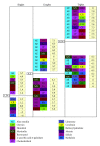Predicting in silico which mixtures of the natural products of plants might most effectively kill human leukemia cells?
- PMID: 23431350
- PMCID: PMC3569894
- DOI: 10.1155/2013/801501
Predicting in silico which mixtures of the natural products of plants might most effectively kill human leukemia cells?
Abstract
The aim of the analysis of just 13 natural products of plants was to predict the most likely effective artificial mixtures of 2-3 most effective natural products on leukemia cells from over 364 possible mixtures. The natural product selected included resveratrol, honokiol, chrysin, limonene, cholecalciferol, cerulenin, aloe emodin, and salicin and had over 600 potential protein targets. Target profiling used the Ontomine set of tools for literature searches of potential binding proteins, binding constant predictions, binding site predictions, and pathway network pattern analysis. The analyses indicated that 6 of the 13 natural products predicted binding proteins which were important targets for established cancer treatments. Improvements in effectiveness were predicted for artificial combinations of 2 or 3 natural products. That effect might be attributed to drug synergism rather than increased numbers of binding proteins bound (dose effects). Among natural products, the combinations of aloe emodin with mevinolin and honokiol were predicted to be the most effective combination for AML-related predicted binding proteins. Therefore, plant extracts may in future provide more effective medicines than the single purified natural products of modern medicine, in some cases.
Figures



Similar articles
-
[Determination of the binding of natural products to the human c-myb oncogene promoter G-quadruplex DNA by capillary electrophoresis and electrospray ionization mass spectrometry].Se Pu. 2020 Sep 8;38(9):1069-1077. doi: 10.3724/SP.J.1123.2020.03001. Se Pu. 2020. PMID: 34213273 Chinese.
-
Prediction of potential cancer-related molecular targets of North African plants constituents using network pharmacology-based analysis.J Ethnopharmacol. 2019 Jun 28;238:111826. doi: 10.1016/j.jep.2019.111826. Epub 2019 Mar 22. J Ethnopharmacol. 2019. PMID: 30910579
-
Quantitative and Systems Pharmacology. 1. In Silico Prediction of Drug-Target Interactions of Natural Products Enables New Targeted Cancer Therapy.J Chem Inf Model. 2017 Nov 27;57(11):2657-2671. doi: 10.1021/acs.jcim.7b00216. Epub 2017 Oct 13. J Chem Inf Model. 2017. PMID: 28956927 Free PMC article.
-
Antitumor properties and modulation of antioxidant enzymes' activity by Aloe vera leaf active principles isolated via supercritical carbon dioxide extraction.Curr Med Chem. 2010;17(2):129-38. doi: 10.2174/092986710790112620. Curr Med Chem. 2010. PMID: 19941474 Review.
-
High impact technologies for natural products screening.Prog Drug Res. 2008;65:175, 177-210. doi: 10.1007/978-3-7643-8117-2_5. Prog Drug Res. 2008. PMID: 18084916 Review.
Cited by
-
Phytochemicals: Extraction, Isolation, and Identification of Bioactive Compounds from Plant Extracts.Plants (Basel). 2017 Sep 22;6(4):42. doi: 10.3390/plants6040042. Plants (Basel). 2017. PMID: 28937585 Free PMC article. Review.
-
Ultrasound Assisted Extraction of Phenolic Compounds from Peaches and Pumpkins.PLoS One. 2016 Feb 17;11(2):e0148758. doi: 10.1371/journal.pone.0148758. eCollection 2016. PLoS One. 2016. PMID: 26885655 Free PMC article.
-
Employing response surface methodology for the optimization of ultrasound assisted extraction of lutein and β-carotene from spinach.Molecules. 2015 Apr 14;20(4):6611-25. doi: 10.3390/molecules20046611. Molecules. 2015. PMID: 25875040 Free PMC article.
-
Simultaneous extraction, optimization, and analysis of flavonoids and polyphenols from peach and pumpkin extracts using a TLC-densitometric method.Chem Cent J. 2015 Jun 20;9:39. doi: 10.1186/s13065-015-0113-4. eCollection 2015. Chem Cent J. 2015. PMID: 26106445 Free PMC article.
References
-
- Wink M, Alfermann AW, Franke R, et al. Sustainable bioproduction of phytochemicals by plant in vitro cultures: anticancer agents. Plant Genetic Resources. 2005;3(2):90–100.
-
- Mishra S, Zhang B, Cunnick JM, Heisterkamp N, Groffen J. Resistance to imatinib of Bcr/Abl P190 lymphoblastic leukemia cells. Cancer Research. 2006;66(10):5387–5393. - PubMed
-
- Sheridan H, Krenn L, Jiang R, et al. The potential of metabolic fingerprinting as a tool for the modernisation of TCM preparations. Journal of Ethnopharmacology. 2012;140:482–491. - PubMed
LinkOut - more resources
Full Text Sources
Other Literature Sources

